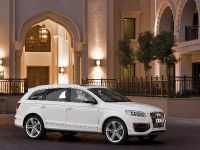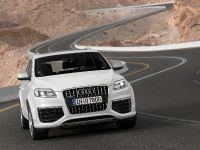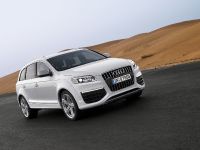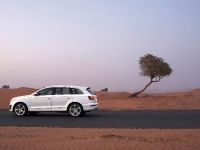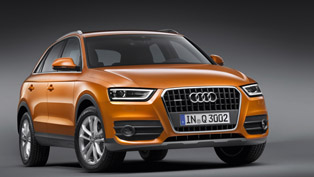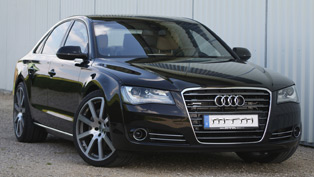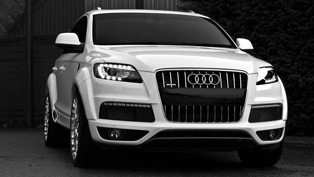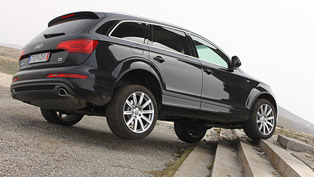Audi Q7 V12 TDI quattro
Masterful technology Audi Q7 V12 TDI quattro For two decades Audi has driven forward the advancement of diesel technology – from the very top. Now the brand with the four rings is presenting another world first: the first V12 TDI in a passenger vehicle. The diesel, which generates an output of 368 kW (500 hp) and 1,000 Nm of torque (737.56 lb-ft) from a capacity of six liters, gives the new Audi Q7 V12 TDI quattro the performance of a sports car. It catapults from zero to 100 km/h (62.14 mph) in only 5.5 seconds and has an electronically capped top speed of 250 km/h (155.34 mph).
The V12 diesel is opening up entirely new horizons in the diesel sector. The bigperformance SUV from Audi completes all intermediate sprints with fascinating ease; in every driving situation it boasts superior reserves of power. The engine captivates its drivers not only with its sheer inexhaustible power but also with its highly cultivated manner of operation – the subtle engine sound takes on a voluminous, strong note when the throttle is open.
In terms of fuel consumption the six-liter TDI, which features a completely redeveloped common rail injection system, requires an average of only 11.3 liters/100 km (20.82 US mpg), substantially less than the gasoline units produced by the competition. No competitor is able to match this achievement.
Engine
The new twelve-cylinder TDI, produced at the Gyor plant in Hungary, is a member of the current family of V diesel engines from Audi, which up to now was restricted to 6 and 8-cylinder units. As with other inline engines, it has a spacing of 90 millimeters (3.54 inches) between cylinder centers. Yet its included angle is 60 degrees, not 90 – the reason is that on this layout of V12, no free inertial forces or mass moments of inertia can then occur. The results are refined in every respect.
The 83.0-millimeter bore (3.27 inches) and 91.4-millimeter stroke (3.60 inches) of the twelve-cylinder are the same as the 3.0 TDI, producing a total displacement of 5,934 cc. The two cylinder banks are positioned opposite one another with an offset of 17 millimeters (0.67 inch). Measuring 684 millimeters (26.93 inches) in length the powerful engine is extremely compact, only 166 millimeters (6.54 inches) longer than the V8 TDI. This dimension was the key prerequisite for integrating the V12 into the Audi Q7.
The V12 TDI crankcase is made from cast iron with vermicular graphite – a hightech material referred to as GJV-450 that is already used on the V6 and V8 TDI engines. GJV-450, made by a patented casting process, is about 40 percent more rigid and 100 percent more fatigue-resistant than gray cast iron. This enabled the developers to make its walls thinner, cutting its weight by around 15 percent compared with conventional gray cast iron. The crankshaft forged from chromemolybdenum alloy steel is mounted with the aid of an extremely rigid main bearing bridge made of nodular cast iron. The forged connecting rods are cracked and the pistons are made of aluminum.
The two cylinder heads are each made from three main elements. The base section is made from a high-strength, lightweight aluminum alloy, through which the coolant flows and where the intake and exhaust ports are incorporated. Above this are an oil-bearing upper section and a reinforcing ladder-type frame supporting the two camshafts. The valves are actuated by low-friction roller cam followers. The compression ratio is 16.0:1.
As usual on the Audi V engines, the no-maintenance chain drive is mounted on the reverse of the engine, where it occupies little space. However, it has a new layout: the camshaft's sprocket engages in an intermediate gear via which two simplex chains drive the camshafts. Two additional chains drive the oil pump and the high-pressure pumps for the common rail injection system – an important innovation for the V12 TDI.
2,000 bar: common rail technology with a new level of performance
The two twin-plunger high-pressure pumps have been completely redeveloped. They can create pressures as high as 2,000 bar in the rails – up to now 1,800 bar was the norm. The piezo injectors with their eight-hole nozzles, each with a diameter measuring only 0.12 millimeters (0.005 inch), have also undergone a fundamental reworking. The high pressure creates an extremely precise spray pattern in the combustion chambers that permits a faster, more homogeneous and therefore more acoustically refined ignition process. The highly efficient combustion process also increases power output, cuts consumption and reduces pollutant emissions.
The current generation of so-called inline injectors utilizes the piezo effect: piezo crystals expand in a fraction of a millisecond when an electrical voltage is applied. Over 300 piezo disks are packed into the V12 TDI injectors, which use the expansion to initiate the injection process directly. Each actuation takes just a few milliseconds – at 100 milliseconds, the wink of an eye lasts much longer.
The number of injection processes per operating cycle can be varied across a wide range thanks to piezo technology – reaching as many as five fuel injection operations. One to two pilot injections ensure smooth engine operation in all load and speed ranges. Delayed post-injection serves to increase the temperature of the exhaust gas in order to regenerate the two particulate filters included as standard.
The two turbochargers are located on the outside of the engine's vee, each of them supplying one bank of cylinders. Thanks to their variable vane geometry the full exhaust flow is directed through the turbines at all times – the turbochargers respond even at low engine speeds and achieve a high level of efficiency.
2.7 bar: high boost pressure
Both turbocharges generate up to 2.7 bar of absolute boost pressure. Two large intercoolers reduce the temperature of the compressed air and thus increase the level of oxygen required for combustion. The V12 TDI features a dual-branch intake system. For each bank of cylinders there is an air filter, behind which an air mass meter is located.
Two ultra-fast control units manage events in the engine, sharing the workload according to a master/slave principle. The six-liter has adopted map-controlled swirl variation of the combustion air from its smaller TDI siblings. The electrically controlled flaps can be adjusted to ensure optimum swirl with respect to high performance and low emissions.
The exhaust system also has a dual-branch design; here Audi engineers focused their attention on exhaust gas recirculation. At partial throttle, up to 50 percent of the exhaust is fed back into the intake air in order to reduce NOx emissions. The large-dimension recirculation system, located at the top of the inner vee, incorporates a water cooler that uses map-based control to lower the temperature of the exhaust gas.
With its 368 kW (500 hp) the diesel generates a specific power output of 62.0 kW (84.3 hp) per liter of capacity – worthy of a sports car. Even more impressive is its maximum torque: between 1,750 rpm and 3,250 rpm the V12 TDI has a constant 1,000 Nm (737.56 lb-ft) on tap – this amounts to 168 Nm (123.91 lb-ft) per liter of capacity. The 11.3 liters of fuel that the potent TDI requires on average per 100 km (20.82 US mpg) is a reflection of its superior efficiency. This figure is even more astounding when compared with gasoline engines offered by the competition – the fuel consumption of these units is much higher all-round.
Transmissions
The mighty engine power of the V12 TDI flows through a fast and extremely smooth-shifting six-speed tiptronic, which was specially designed for the immense torque of the six-liter diesel. The driver can shift the gears of the automatic transmission either manually with the selector lever or with the standard chromed shift paddles on the three-spoke leather-covered steering wheel.
The quattro drive distributes the power to the front and back wheels in a 40:60 ratio – giving the vehicle a sporty, rear-focused driving style that guarantees maximum agility and driving enjoyment. When needed, the inter-axle differential transfers most of the power to the axle with better traction. Great care has also been devoted to reinforcing all key components in the quattro driveline.
Chassis
The chassis of the Audi Q7 V12 TDI quattro is a marvel of high-tech construction. Double wishbones guide the front and rear wheels; the axle components are made primarily of aluminum. Thanks to the extreme precision and directness of the servotronic steering, the driver remains in close contact with the road. This is where the handling characteristics, driving safety and comfort of the performance SUV set the benchmark.
Even in rough terrain the Audi Q7 V12 TDI quattro can easily cope with the challenges – with a maximum ground clearance of 240 millimeters (9.45 inches). The ESP stabilization system features hill descent assist and a special off-road mode which optimizes traction.
The standard adaptive air suspension works with sporty new tuning. In combination with electronically controlled shock absorbers incorporating dynamic roll stabilization, the air suspension can be adjusted in three zones ranging from extremely comfortable to highly dynamic. The driver can also adjust ground clearance in five stages via this system and lower the tail end by 71 millimeters (2.80 inches) for comfortable loading.
The ultimate performance SUV from Audi is fitted with sporty 20-inch cast aluminum wheels with a ten-spoke design. Alternatively, wheels with a 20-spoke design are available, as are impressive 21-inch wheels in a choice of three different designs.
Behind the large wheels is a powerful 20-inch brake system. Made of ceramic reinforced with carbon fiber, the internally ventilated disks are notable for their low weight, robust performance and minimum wear. As on a high-performance sports car, eight-piston calipers grip the disks at the front axle, while the rear brakes each have four pistons. The calipers are painted in Titanium Gray – the front ones bear the lettering "Audi ceramic".
Design
The visual styling of the Audi Q7 V12 TDI quattro gives the vehicle an unmistakable look. Daytime running lights consisting of twelve white LEDs per headlight announce the vehicle's presence even at a distance. They are located on the upper edge of the air intake slots, replacing the turn signals that were moved to the bi-xenon headlights. Further honing the vehicle's profile are vertical chromed bars in the grid of the single-frame radiator grill and an underbody protector made of stainless steel. The newly designed bumper groups the highly polished side air intake slots into large units.
When viewed from the side, both the 20-inch wheels and the matt aluminum caps on the exterior mirrors catch the eye. The wheel arches have been widened a total of 26 millimeters (1.02 inches) at the front and 30 millimeters (1.18 inches) at the rear; the lower edges of the doors flaunt striking new moldings. The windows are framed by matt aluminum cover strips; the roof rails sport the same look. The taillights are set in a dark-colored background, while the newly designed bumper incorporates two large, oval exhaust tailpipes. At the rear, the underbody protector is also made from stainless steel. A metallic or pearl effect finish comes as standard.
The Q7 V12 TDI quattro impresses with its elegant and dynamic styling. The ultimate performance SUV from Audi has a powerful and elongated look; with a length of 5,063 millimeters (199.33 inches), a width of 2,000 millimeters (78.74 inches) and a height of 1,737 millimeters (68.39 inches) it boasts the sportiest dimensions in its class.
High side panels lend the vehicle body a muscular appearance, particularly in contrast with the flat, sporty window area. The dynamic line above the wheel arches, the powerful shoulder section and the flowing roof line together with the standard roof rails underline the vehicle's athletic looks. The pronounced tapering of the front section and the rear end with its sharply sloping D-posts fashion a coupe-like silhouette.
The interior and the cockpit area create a sense of light and airy spaciousness, perfect ergonomics and excellent quality. Audi offers customers a choice of four, five, six or seven highly versatile seats. Depending on seating capacity, the cargo area can hold up to 2,035 liters (71.87 cubic feet).
Aluminum inlays shine in the door sill trims and the carpet is made of velour. Carbon fiber covers and the aluminum-look selector lever give the center tunnel a high-tech ambience, exclusive wood trim is available as an option. The buttons of the MMI operating system, which has proven a superior concept in numerous independent tests, gleam in silver, the air vents in aluminum, the pedals and footrest in stainless steel.
Verano leather covers the electrically adjustable sport seats; the deluxe center armrest and the armrests in the doors are upholstered with leather as well. The front and rear seats can be heated; a special lighting package softly illuminates the interior.
Equipment
Also included in the luxurious standard specification for the Audi Q7 V12 TDI quattro are the leather package, leather multifunction sports steering wheel, black roof lining, folding exterior mirrors, DVD navigation system, Bose Surround Sound system with CD changer, Bluetooth mobile phone preparation, alarm system and tire pressure monitoring system.
The tailgate opens and closes electrically – it partly overlaps the D-posts, lending a muscular look to the rear end. The standard deluxe automatic air conditioning regulates heating and ventilation separately for the driver's and front passenger's side, taking sunlight levels into account at the same time.
Audi offers four optional high-tech assistance systems for the Q7 V12 TDI quattro: adaptive cruise control, Audi lane assist and Audi side assist help the driver to maintain the correct distance from the vehicle in front, stay in lane and change lanes. Audi parking system advanced includes a camera to monitor the area behind the vehicle.
The multimedia system becomes even more versatile with the optional Audi music interface, a convenient connection point for the customer's iPod. Available on request is the Advanced Sound System from Bang & Olufsen, which offers a totally unparalleled sound experience.
The leather package advanced offers even more comfort in the interior, and includes exclusive coverings for the dashboard and centre console. The large glass sunroof – the open sky system – and a rail system for the cargo area further enhance the appeal of the Q7 V12 TDI quattro as a touring vehicle.
The Q7 V12 TDI quattro, the exclusive top model in the series, makes its way to dealers towards the end of 2008.
TDI from Audi – the superior technology
The six-liter TDI unit is further impressive proof of the technological leadership embodied in Audi's "Vorsprung durch Technik" slogan. Back in 1989, the brand with the four rings put the TDI principle into series production and since then it has applied its full innovative power to continually push forward the boundaries of what is possible. The TDI engines play a vital role in shaping the character of Audi as a sporty premium brand; today every second Audi sold worldwide has a diesel engine under the hood. The TDI engine, the most successful efficiency technology in the world has an inimitable string of victories under its belt – and it continues under full power.
The new V12 TDI in the Audi Q7 is closely related to the engine that has already taken the Audi R10 TDI racing car to overall victory three times in the Le Mans 24 Hours. The 5.5 liter TDI is a race engine of superior pedigree. With more than 1,100 Nm (811.32 lb-ft) of torque it outstrips all gasoline engines by far; at the engine's rated speed it generates more than 650 hp, enough for a top speed of around 330 km/h (205.05 mph).
The mighty diesel engine has impressively demonstrated its prowess at the 24-hour race in Le Mans and in many rounds of the American Le Mans series. Among its virtues is fuel efficiency. Compared with its predecessor, the already highly efficient R8 with gasoline direct injection, the Le Mans version of the R10 TDI is markedly more economical.
Triumphant: three Le Mans victories in a row
Excellent efficiency was the key to three successive victories on the traditionladen circuit in France. Frank Biela (Germany), Emanuele Pirro (Italy) and Marco Werner (Germany) won very convincingly in 2006. The same team of drivers again won in 2007, even though the organizers had capped the tank capacity of the R10 TDI. And in 2008 Rinaldo Capello (Italy), Allan McNish (Scotland) and Tom Kristensen (Denmark) achieved the third victory in a row – in very difficult weather conditions, as in the previous year. At Audi, superior performance and maximum efficiency are inextricably linked.



